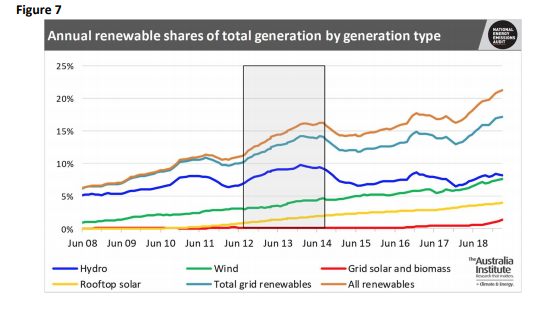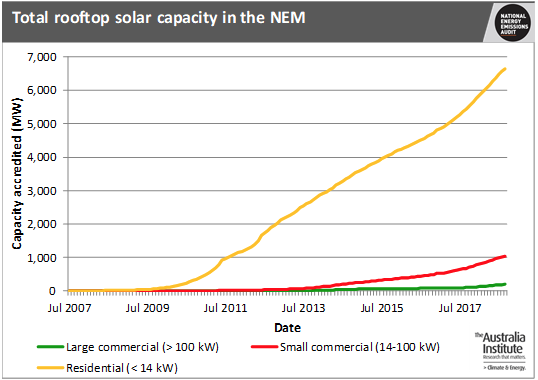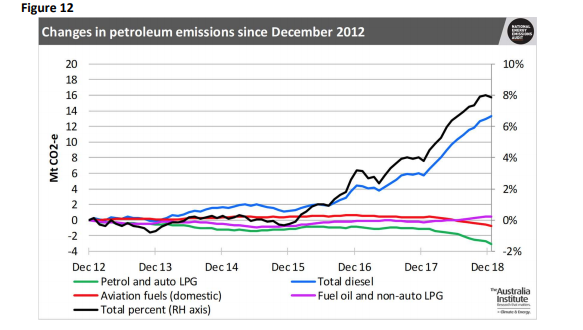In its latest National Energy Emissions Audit, The Australia Institute (TAI) points out that wind and solar – both large scale and rooftop – continue to eat into the pie previously reserved for coal and gas. Consequently, emissions from the electricity sector have been on a downward trajectory for the last three years, while overall emissions continued to increase with big jumps seen in the transport sector.
In this period, there has been no systematic or sustained change in total demand in the NEM, mostly thanks to growing rooftop solar generation. The Audit finds that the renewable energy share of Australia’s electricity generation has risen to 21.2% at the expense of brown coal generation, as well as gas generation as continuing high prices are prompting both business and residential consumers to consider shifting away from gas towards cheaper and cleaner renewables.

TAI underlines the big role played by rooftop solar, noting that this market segment has been a great success story. The rooftop fleet continues to grow and is now generating over 4% of the total electricity used in the NEM, with the lion’s share in the residential sector, the Audit finds. The cumulative capacity presently stands at around 6.6 GW, generating over 7.5 TWh per year.
“In addition to powering homes, they [rooftop solar systems] continue to assist the grid by reducing peak demand on very hot days,” says Hugh Saddler, energy expert and report author. In another recent report, The Australia Institute found that renewables performed the best of all energy sources during the record-breaking summer of heatwaves, with a major contribution from both rooftop and large-scale solar farms, while coal clunkers were operating well below capacity.

The latest report, however, notes that the present moment seems very much like an inflection point in the NEM, given that the large pipeline of new wind and solar farms has recently slowed because of network constraints changes and changes to Marginal Loss Factors (MLFs) affecting grid scale wind and solar farms.
Thus far, new connection requirements and bottlenecks have seen over 4.5 GW of renewable energy projects queuing to be accommodated on the grid. As shown by the MLFs figures released by the Australian Energy Market Operator (AEMO) earlier this month, utility-scale renewable energy projects are facing a risk of a higher transmission loss in the next financial year due to generation exceeding the carrying capacity of transmission lines. This has highlighted the ongoing need for comprehensive planning of both generation and transmission.
In terms of emissions, the good result in the electricity sector has been overshadowed by galloping transport emissions. “Transport emissions continue unfettered by any constraints and as we have repeatedly noted, unless and until Australia has a set of genuine policies directed at decisively changing the trend of transport energy consumption, transport-related emissions will continue their inexorable growth,” the report reads.
While drivers are reportedly keen to make the switch to electric vehicles, there has been a vacuum in policy leadership. The Coalition government recently released a national strategy for electric vehicles – a single page document which is supposed to ensure the transition to EV technology and infrastructure. But while the document states that addressing these issues now is necessary, itdoes not put forward any target or a clear policy.
TAI also warns that continuing growth in use of petroleum fuels for transport also presents supply security challenges. According to the report, in 2017-18, imported crude oil and petroleum products supplied 97% of Australia’s total consumption of petroleum products, expressed in terms of simple volumes. “When account is taken of exports from Australia, dependence on imports falls to 71% in net terms. However, about half of the exports are condensate (very light hydrocarbons), which cannot be used to any significant extent by Australian oil refineries to produce transport fuels. It follows that Australia’s petroleum import dependence is well over 80% in “true” net terms.”
“We still have a major problem with growing transport emissions and any future Government must prioritize fuel efficiency standards,” Saddler says. “Efforts to prioritize fuel efficiency standards have dragged on for years and made little progress, leaving Australia firmly in the minority 20% of countries with no standards and costing Australians more per kilometer travelled.”

This content is protected by copyright and may not be reused. If you want to cooperate with us and would like to reuse some of our content, please contact: editors@pv-magazine.com.









1 comment
By submitting this form you agree to pv magazine using your data for the purposes of publishing your comment.
Your personal data will only be disclosed or otherwise transmitted to third parties for the purposes of spam filtering or if this is necessary for technical maintenance of the website. Any other transfer to third parties will not take place unless this is justified on the basis of applicable data protection regulations or if pv magazine is legally obliged to do so.
You may revoke this consent at any time with effect for the future, in which case your personal data will be deleted immediately. Otherwise, your data will be deleted if pv magazine has processed your request or the purpose of data storage is fulfilled.
Further information on data privacy can be found in our Data Protection Policy.